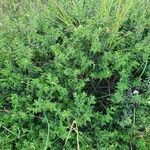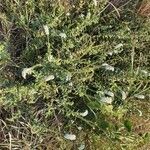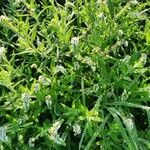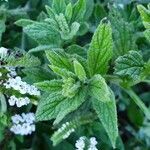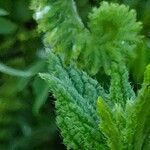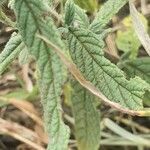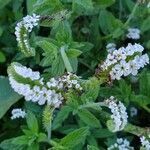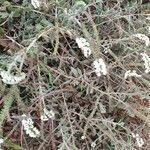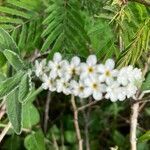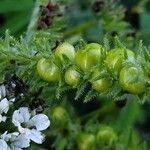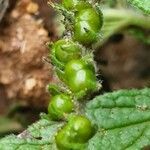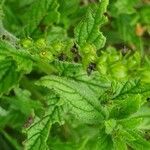Erect or procumbent perennial herb 60-90 cm high, woody to the base, sometimes with a thick rootstock; stems and branches ± densely clothed with short appressed hairs with a few longer spreading ones. Leaves alternate, sessile or with petiole up to 6 mm long; lamina 20-60(80) x 4-15 mm, lanceolate, pubescent to rough above, pubescent to subglabrous below, acute to obtuse at apex, cuneate at base and sometimes decurrent on the petiole, margins slightly revolute and sometimes undulate to crisp and with 3-5(6) secondary nerves on each side of the midrib. Cymes up to 12(18) cm long when full expanded, single or in pairs, terminal. Flowers sessile or subsessile. Calyx 2.5-3.5(4.5) mm long, hairy outside, hairy to glabrous inside; lobes narrowly triangular to linear, obtuse, stellate-spreading after the nutlets are shed. Corolla quite white or with yellow throat; tube 3.5-5.5 mm long, appressed hairy outside, glabrous inside; lobes 1.3-2.0 x 1.1-1.8 mm oblong to subquadrate, obtuse to truncate, usually with very undulate margins, unequal, spreading. Stamens inserted at the middle of the corolla tube; anthers 1.4-1.8 mm long, oblong, apiculate, glabrous, often glaucous, subsessile. Ovary ovoid-conical, glabrous. Style 1.0-1.5 mm long, terete, glabrous; stigmatic ring 0.5-0.7 mm in diam.; sterile appendix 0.7-1.0 mm long, as broad at the base as the stigmatic ring, papillose. Fruits 3-4 mm long, coarsely obpyriform and depressed between the pairs of nutlets or more often strongly asymmetrical by abortion of 1-3 seeds, smooth, glabrous; nutlets connate in pairs, each pair emarginate at apex.
Leaves alternate, sessile or with petiole up to 6 mm. long; lamina 20–60(80) x 4–15 mm., lanceolate, pubescent to rough above, pubescent to subglabrous below, acute to obtuse at apex, cuneate at base and sometimes decurrent on the petiole, margins slightly revolute and sometimes undulate to crisp and with 3–5(6) secondary nerves on each side of the midrib.
Erect or procumbent perennial herb, 0.6-0.9 m high. Leaves lanceolate. Corolla lobes oblong to subquad-rate, obtuse to truncate, tube with antrorse hairs. Style well developed. Fruit ± obpyriform, not pustulate, glabrous; nutlets cohering in pairs. Flowers white or with yellow throat.
Corolla quite white or with yellow throat; tube 3.5–5.5 mm. long, appressed hairy outside, glabrous inside; lobes 1.3–2.0 x 1.1–1.8 mm. oblong to subquadrate, obtuse to truncate, usually with very undulate margins, unequal, spreading.
Fruits 3–4 mm. long, coarsely obpyrifonn and depressed between the pairs of nutlets or more often strongly asymmetrical by abortion of 1–3 seeds, smooth, glabrous; nutlets connate in pairs, each pair emarginate at apex.
Erect or procumbent perennial herb 60–90 cm. high, woody to the base, sometimes with a thick rootstock; stems and branches ± densely clothed with short appressed hairs with a few longer spreading ones.
Style 1.0–1.5 mm. long, terete, glabrous; stigmatic ring 0.5–0.7 mm. in diam.; sterile appendix 0.7–1.0 mm. long, as broad at the base as the stigmatic ring, papillose.
Calyx 2.5–3.5(4.5) mm. long, hairy outside, hairy to glabrous inside; lobes narrowly triangular to linear, obtuse, stellate-spreading after the nutlets are shed.
Stamens inserted at the middle of the corolla tube; anthers 1.4–1.8 mm. long, oblong, apiculate, glabrous, often glaucous, subsessile.
Cymes up to 12(18) cm. long when full expanded, single or in pairs, terminal.
Ovary ovoid-conical, glabrous.
Flowers sessile or subsessile.
A tree.
